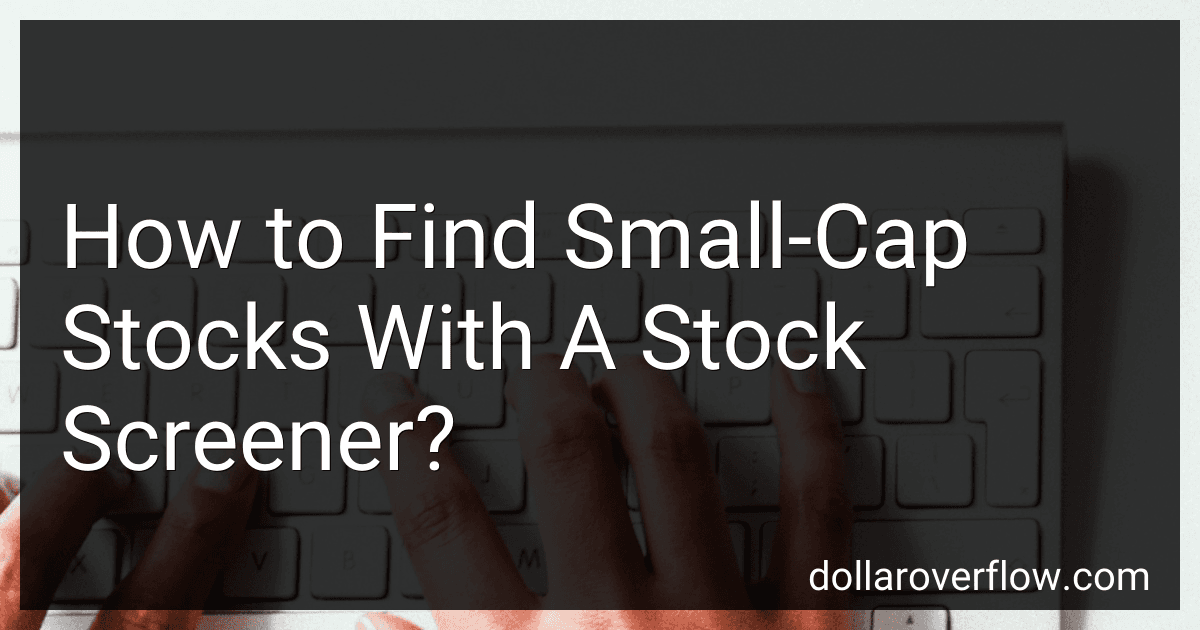Posts (page 192)
-
 7 min readIdentifying uptrend stocks typically involves looking for stocks that have consistently been increasing in price over a certain period of time. This can be done by analyzing a stock's historical price movements and patterns, such as higher highs and higher lows. Additionally, examining technical indicators like moving averages, relative strength index (RSI), and MACD can help confirm the presence of an uptrend.
7 min readIdentifying uptrend stocks typically involves looking for stocks that have consistently been increasing in price over a certain period of time. This can be done by analyzing a stock's historical price movements and patterns, such as higher highs and higher lows. Additionally, examining technical indicators like moving averages, relative strength index (RSI), and MACD can help confirm the presence of an uptrend.
-
 5 min readScreening for stocks with positive earnings surprises involves using various financial metrics and ratios to identify companies that have reported stronger earnings than expected by analysts. Some key factors to consider in this screening process include looking for stocks that have beaten earnings estimates in the recent quarters, have a history of consistent earnings growth, and have upward revisions in earnings forecasts by analysts.
5 min readScreening for stocks with positive earnings surprises involves using various financial metrics and ratios to identify companies that have reported stronger earnings than expected by analysts. Some key factors to consider in this screening process include looking for stocks that have beaten earnings estimates in the recent quarters, have a history of consistent earnings growth, and have upward revisions in earnings forecasts by analysts.
-
 5 min readTo find stocks with low volatility, you can start by looking at the historical volatility of different stocks. This can be measured by looking at past price movements and fluctuations. Additionally, you can use technical indicators such as the Average True Range (ATR) or the Relative Strength Index (RSI) to gauge the volatility of a stock. Another approach is to look for stocks in stable industries or sectors that tend to have lower volatility.
5 min readTo find stocks with low volatility, you can start by looking at the historical volatility of different stocks. This can be measured by looking at past price movements and fluctuations. Additionally, you can use technical indicators such as the Average True Range (ATR) or the Relative Strength Index (RSI) to gauge the volatility of a stock. Another approach is to look for stocks in stable industries or sectors that tend to have lower volatility.
-
 7 min readOne way to screen for stocks with high analyst ratings is to use a stock screening tool or platform that filters stocks based on analyst ratings. These tools typically provide a list of stocks that have received favorable ratings from analysts, which can help you identify potential investment opportunities.You can also manually search for stocks that have high analyst ratings by keeping track of analyst reports and recommendations from reputable sources.
7 min readOne way to screen for stocks with high analyst ratings is to use a stock screening tool or platform that filters stocks based on analyst ratings. These tools typically provide a list of stocks that have received favorable ratings from analysts, which can help you identify potential investment opportunities.You can also manually search for stocks that have high analyst ratings by keeping track of analyst reports and recommendations from reputable sources.
-
 8 min readFinding blue-chip stocks using a stock screener involves utilizing specific criteria to filter through thousands of stocks and identify those that fit the blue-chip classification. Some common criteria to look for include companies with a long history of stable and increasing revenue, consistent profitability, strong balance sheets, and high market capitalization.
8 min readFinding blue-chip stocks using a stock screener involves utilizing specific criteria to filter through thousands of stocks and identify those that fit the blue-chip classification. Some common criteria to look for include companies with a long history of stable and increasing revenue, consistent profitability, strong balance sheets, and high market capitalization.
-
 8 min readTo find international stocks using a stock screener, you will need to specify your criteria for the search. Start by selecting the region or country you are interested in, such as Europe, Asia, or specific countries like Japan or Germany.Next, you can filter the results by market cap, industry sector, dividend yield, or other financial metrics. Make sure to adjust the settings on the screener to include international exchanges or stock markets in your search.
8 min readTo find international stocks using a stock screener, you will need to specify your criteria for the search. Start by selecting the region or country you are interested in, such as Europe, Asia, or specific countries like Japan or Germany.Next, you can filter the results by market cap, industry sector, dividend yield, or other financial metrics. Make sure to adjust the settings on the screener to include international exchanges or stock markets in your search.
-
 7 min readScreening for stocks by sector can be done by utilizing various stock screening tools available online, such as financial websites or brokerage platforms.To screen for stocks by sector, you can first select the specific sector or industry you are interested in. This can be based on your investment strategy or market outlook.Next, you can filter stocks within that sector based on certain criteria, such as market cap, P/E ratio, dividend yield, revenue growth, or earnings per share.
7 min readScreening for stocks by sector can be done by utilizing various stock screening tools available online, such as financial websites or brokerage platforms.To screen for stocks by sector, you can first select the specific sector or industry you are interested in. This can be based on your investment strategy or market outlook.Next, you can filter stocks within that sector based on certain criteria, such as market cap, P/E ratio, dividend yield, revenue growth, or earnings per share.
-
 5 min readBeta is a measure of a stock's volatility in relation to the overall market. Stocks with high beta tend to be more volatile, meaning their price movements are more exaggerated compared to the market as a whole. To screen for stocks with high beta, investors can use financial websites or platforms that provide beta values for individual stocks. They can then sort or filter stocks based on their beta values to identify those with high beta.
5 min readBeta is a measure of a stock's volatility in relation to the overall market. Stocks with high beta tend to be more volatile, meaning their price movements are more exaggerated compared to the market as a whole. To screen for stocks with high beta, investors can use financial websites or platforms that provide beta values for individual stocks. They can then sort or filter stocks based on their beta values to identify those with high beta.
-
 8 min readTo find small-cap stocks using a stock screener, you can start by setting specific criteria such as market capitalization, price-to-earnings ratio, and average trading volume. Small-cap stocks are typically companies with a market capitalization between $300 million and $2 billion.Use the stock screener to filter out large-cap and mid-cap stocks and focus on small-cap stocks that match your criteria.
8 min readTo find small-cap stocks using a stock screener, you can start by setting specific criteria such as market capitalization, price-to-earnings ratio, and average trading volume. Small-cap stocks are typically companies with a market capitalization between $300 million and $2 billion.Use the stock screener to filter out large-cap and mid-cap stocks and focus on small-cap stocks that match your criteria.
-
 8 min readScreening for stocks with strong cash flow involves looking for companies that are generating a significant amount of cash from their operational activities. This can be done by analyzing a company's cash flow statement, which shows how much cash is coming in and going out of the business.One key metric to look at is the company's free cash flow, which is the amount of cash remaining after all expenses and investments have been accounted for.
8 min readScreening for stocks with strong cash flow involves looking for companies that are generating a significant amount of cash from their operational activities. This can be done by analyzing a company's cash flow statement, which shows how much cash is coming in and going out of the business.One key metric to look at is the company's free cash flow, which is the amount of cash remaining after all expenses and investments have been accounted for.
-
 5 min readTo find stocks with high earnings growth, investors can start by looking at the financial statements of companies to identify those that have consistently shown strong earnings growth over time. This can be done by analyzing key financial ratios such as earnings per share (EPS), revenue growth, and profit margins.Additionally, investors can look for companies in fast-growing industries or sectors that are expected to outperform the broader market.
5 min readTo find stocks with high earnings growth, investors can start by looking at the financial statements of companies to identify those that have consistently shown strong earnings growth over time. This can be done by analyzing key financial ratios such as earnings per share (EPS), revenue growth, and profit margins.Additionally, investors can look for companies in fast-growing industries or sectors that are expected to outperform the broader market.
-
 5 min readTo screen for stocks with a low debt-to-equity ratio, you can use various financial websites or screening tools that allow you to filter stocks based on different financial ratios.One way to do this is by looking for companies with a debt-to-equity ratio lower than the industry average or sector average. This can give you an idea of how a company's debt levels compare to its peers.You can also use financial databases to search for companies with low levels of debt relative to their equity.
5 min readTo screen for stocks with a low debt-to-equity ratio, you can use various financial websites or screening tools that allow you to filter stocks based on different financial ratios.One way to do this is by looking for companies with a debt-to-equity ratio lower than the industry average or sector average. This can give you an idea of how a company's debt levels compare to its peers.You can also use financial databases to search for companies with low levels of debt relative to their equity.